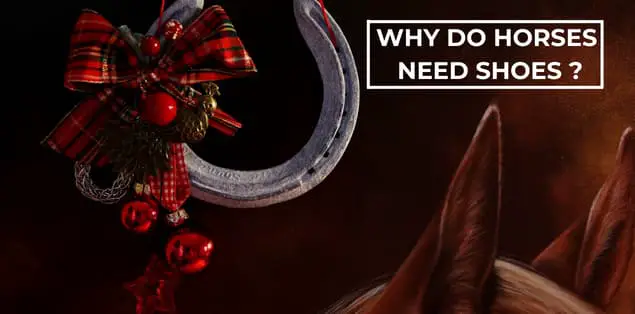So, why do horses need shoes? If you take a metal horseshoe and place it in your hand, its weight will be the first thing that jumps out at you! It’s hard to imagine, but you affix these metal devices to horses’ feet.
Throughout the year, you may hear a variety of horse species clopping about in horseshoes. This raises a direct question: why is it necessary for horses to wear them?
In this article, we’ll find out why horseshoes are necessary for horses, what materials horseshoes are made of and who places them on a horse’s feet.
So, without any further ado, let’s jump right into it!
Why Do Domestic Horses Need Shoes?
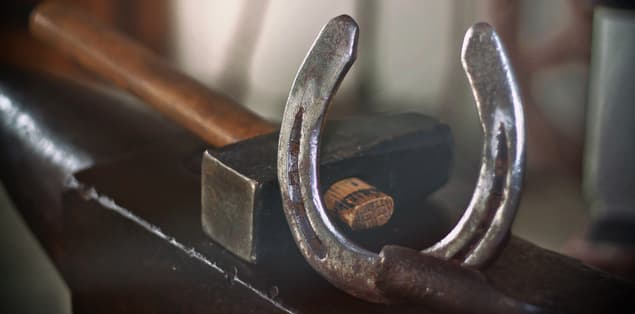
Horseshoes aren’t necessary for every horse. A horse can have no shoes on at all. However, there are a few good reasons why domestic horses should have to wear them.
For Protection
Protecting a horse’s hooves is a horseshoe’s principal job. A horse’s hooves are comparable to the toenails on a human foot. Keratin is the protein that makes up both hooves and toenails. They behave similarly to human toenails because just like toenails, hooves also must be clipped and filed as they grow.
To understand why horses need horseshoes, you can compare the lifestyles of wild horses to those of domesticated horses and look at the differences. Free-ranging horses, or wild horses, travel over a variety of landscapes. This type of terrain wears down their hooves, and assists in maintaining them at a healthy length and preventing overgrowth . In addition, a wild horse that lives in a dry area spends most of its time walking on hard surfaces.
Because of this, their hooves become more robust and thick. For example, a horse with thick hooves is less likely to damage itself if it walks on a sharp object or rock.
Alternately, a horse that lives on a farm or ranch does not have the same tendency to roam as a horse that lives in the wild. Instead, the topography is probably uniform over the whole of the land. Therefore, to prevent the hooves of a domesticated horse from becoming too lengthy, a farrier must regularly trim and file them.
Consider the regions that are home to most horse – farms, ranches, and barns. The terrain in these places is soft and maybe even muddy at times. Walking on such a comparatively soft terrain does not strengthen the hooves of a domesticated horse.
Because of the type of ground that domesticated horses roam on, their hooves gradually become less strong over their lives. This may encourage some horse owners to shoe their equines.
For Carrying Additional Weight
Weight is another reason a domesticated horse must have shoes on its hooves. A tamed horse can carry far more weight than its wild counterpart. Some tamed horses, for instance, are ridden by persons of varying heights and weights. Tamed horses formerly drew wagons, plows, and carts in many parts of the world.
There are still horses in use today to pull carts and wagons. The hooves of a domesticated horse become more susceptible to damage due to the additional weight the animal must bear. It is even possible that their hooves may shatter and fracture due to this.
A horse kept in its stall for long periods stands on ground that gets damp and wet over time. Because the horse urinates on the stall floor, the straw or bedding used to cover the floor might get wet. Urine has ammonia, a chemical capable of degrading the more delicate components of a horse’s hoof and may be found in urine.
Do Horses Need Shoes in the Wild?
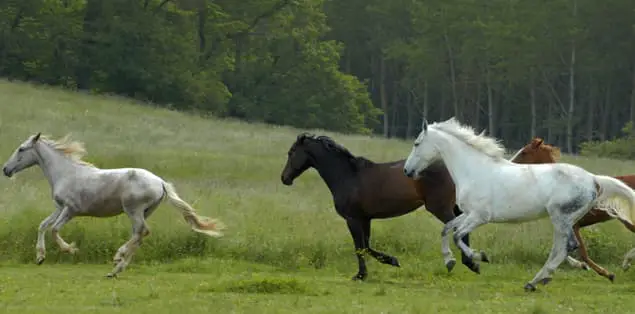
No. They don’t.
You may come across a horse that’s missing all of its horseshoes every once in a while. In addition to this, wild horses do not have shoes on their feet. In the world of labor, horses that do not wear shoes often don’t wear them because they suffer from foot conditions.
Sometimes their hooves are too fragile, or they may have broken off a portion of their hoof. As a result, the shoe will not connect to their hoof appropriately. However, these horses will still be able to go on trail rides and help around the farm. However, the horseshoe will severely restrict the amount of labor they can do.
There are two reasons why wild horses can survive without shoes:
- First, they do not “work” as often or as strenuously as a horse owned by someone. As a result, their hooves wear down at a rate lower than the rate at which they grow.
- Second, they do not have anybody to look after their well-being. Hence, if they have an injured hoof or a similar condition wherein you would place a shoe, it is up to them to deal with it.
Do Horseshoes Hurt the Horse?
Well, it depends.
The horseshoe is attached to the horse’s hoof using nails that you push through the wall of the hoof. Because of this, many people have the misconception that putting on and taking off this shoe may be excruciating for both the horse and the person. However, in truth, neither of these processes cause any discomfort at all.
The good thing is that the nails used to keep the shoes in place only go through that portion of the hoof that does not have nerves. This eliminates any discomfort associated with putting on or removing horseshoes. In a nutshell, shoeing a horse does not include any harsh, inhumane, or painful practices.
The vast majority of horses do not even react while you shoe them. If they could communicate with humans, they would most likely explain that getting shoed is similar to having your nails clipped.
What Are Horseshoes Made Of?
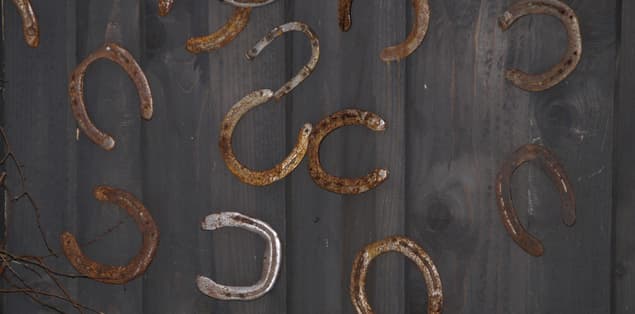
Mostly metals.
A horseshoe is a plate in the form of a U shape that manufacturers make specifically to protect and improve a horse’s hooves. Domesticated horses have been able to indulge in a wider variety of labor activities thanks to the use of horseshoes. The term “shod horse” refers to a horse that is shod with shoes, whereas “unshod” or “barefoot” refers to a horse that does not have shoes on its feet.
Manufacturers often construct the footwear using metals such as steel or aluminum. However, it is also possible for the manufacturers to make shoes using other materials such as rubber, plastic, or copper. The palmar, or ground, side of the hoof is where the horseshoe is attached; nails are the most common attachment method.
If the farrier is proficient, the horse will not experience any discomfort from the nails. It’ll be the same thing as you cutting your nails with a set of nail clippers. However, when just short-term protection is required, it is sometimes advisable to glue the shoes on rather than nail it.
How Often Do Horses Need New Shoes?
It is recommended that you have a farrier adjust the shoes on your horse every 6 weeks as a general rule. If you want to know for sure whether or not your horse needs its shoes adjusted, here are some symptoms to look out for:
- Nails that have become loose and are protruding from the hoof surface.
- Nails that appear to emerge farther out from the shoe on the bottom
- A shoe becomes loose or comes off together.
- The hoof starts to overgrow the shoe and starts getting out of shape.
- The shoe becomes excessively thin or unevenly worn.
- The shoe seems twisted on foot.
It is not a smart practice to put it on hold until you detect one of these items before doing a reset, even if all of these signals indicate that it is time to do so. Instead, the majority of these symptoms point to the fact that the horseshoes have been on for an excessive amount of time. Always remember that nails can loosen and shoes can twist prematurely.
A typical rule of thumb for maintaining healthy hooves is to trim them every six weeks. This is also the time when you should trim the hooves of a barefoot horse. It’s possible that some horses may need a reset sooner, while others will be able to continue for a little bit longer. In any event, you shouldn’t keep your shoes on for months at a time. This may cause injury to the hoof, and hooves that are allowed to overgrow can cause harm to soft tissue, such as strained ligaments and tendons.
Do Horses Need Shoes for Trail Riding?
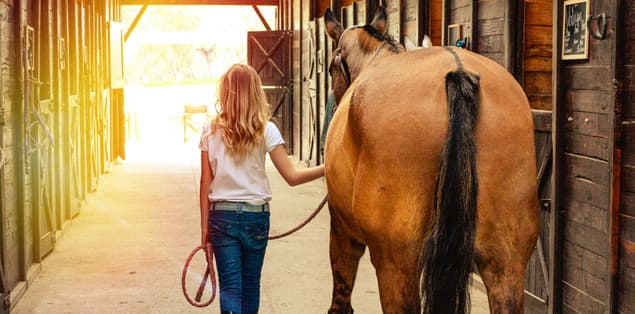
Not necessarily.
As a species, horses can get along just fine without shoes, and they certainly aren’t required to put any on when they go on paths or trails. Trail riding offers a chance to discover areas of the environment that would otherwise be unavailable and provides pleasant fitness activities in which people and horses alike may engage.
Unfortunately, most horses you do not shod will pick up some pebbles, gravel, or dirt in the space between their hooves and the ground.
This might result in a very unpleasant ride for the rider on the horse. When this occurs, take a break from riding your horse on trails instead of going for a barefoot ride or any other activity that will allow the horse’s feet to rest and recover.
Horseshoes should be placed on the hooves of horses traveling across the sandy and rocky terrain so that the horseshoe protects the hooves from jagged rocks and other debris.
Pros and Cons of Shoeing Horses?
As brought out above, there are valid points to be made both for and against shoeing. But can you tell more about them? In this section, we’ve laid out the primary benefits and drawbacks of shoeing a horse so that you may assess your alternatives and get to the best-educated conclusion possible.
Pros of Shoeing
Protection: Shoes provide additional durability and strength, which helps protect the hooves. While riding on rough terrain or putting in strenuous effort, a horseshoe will lower the likelihood of being hurt.
A slower rate of wear: Shoes can prevent the hooves from wearing out too quickly, which can be especially helpful for horses engaged in work that involves a lot of weight-bearing, such as pulling carriages. Shoes can also protect the hooves from damage, such as cuts and scrapes, that extreme working conditions cause.
Some equestrians believe shoeing improves their horse’s overall performance, which in turn benefits the rider. For example, it’s possible that horses that participate in high-impact activities, like high-level jumping or cross country work perform better when they have horseshoes.
To rectify problems: Problems with a horse’s gait, stride, and balance, can benefit from corrective shoeing, which wil assist in fixing these issues. For example, you can also accomplish the repair of chips or cracks in the hoof by shoeing.
Extra support for horses with medical disorders: Horses that suffer from or have suffered from health diseases such as arthritis, ringbone, or laminitis may benefit from the shoeing. This is because horseshoes give additional support to the hoof.
Cons of shoeing
Increased likelihood of injury: If the farrier does not properly shoe the horse, rogue or “hot” nails may hurt the delicate inner section of the hoof. This can also happen if the farrier is inexperienced. For example, a horse can get a tendon strain or injury to the hoof wall if it “springs” (loses) a shoe while the farrier is putting it.
The cost of shoeing an animal is much more than the cost of trimming the animal alone.
Pros and Cons of Going Barefoot
Here are some pros and cons of barefooting horses:
Pros of Barefooting
The many advantages of walking about barefoot
- Because you won’t have to pay for shoes, trimming the hooves on their own is often more cost-effective than having shoes put on them.
- Enhanced performance: Some equestrians feel that their horses are more sound and have improved performance when they are not shod, particularly when working in an arena.
- More natural: Wild horses do not have to wear shoes. Hence, some people feel that maintaining a horse in a condition similar to its natural state is better for the horse’s health and will make it more comfortable. On the other hand, there is no assurance that this will be the case for every horse.
Cons of Barefooting
- Regular hoof care and a healthy diet can help build up the strength and resiliency of the hoof and sole. There is always the possibility that the horse will suffer a stone bruise or another injury while you are working it.This is because the horse’s hooves are not properly maintained. However, this is also the case with horses you’ve shod; neither choice guarantees that the horse will not sustain an injury.
- You may require more cutting and upkeep: It is necessary for owners of unshod horses to be extremely careful about examining, clipping, and otherwise taking care of their horses’ hooves and feet, which may be a time-consuming process.
- Even horses used to staying barefoot may require more protection or traction in certain situations. This is because there are some situations where it is important to offer additional protection or traction. If horses are barefoot, you won’t achieve this objectiveFor instance, if the competition or hacking occurs in very wet or muddy circumstances or on extremely hard or ice terrain, the horse can benefit from having temporary shoes or boots placed on it.
How Do You Know If Shoeing Is Right for Your Horse?
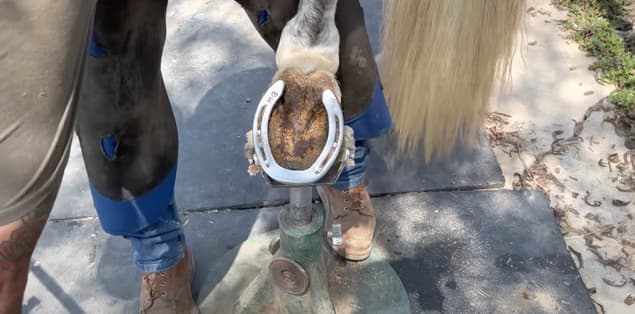
Shoeing your horse is a very discretionary decision that you should make individually. Since there is no universally applicable choice like horseshoes, you must adopt a tailored strategy to match your horse’s requirements to get the best results.
When making your choice, it is essential to consider the benefits and drawbacks of wearing shoes and being barefoot. You’ll also need to keep in mind your own specific needs and circumstances, making sure to take into consideration the following aspects:
- The kind of task they are now engaging in – Are they putting in tough labor, or are they engaging in intense training? Is it possible that the hooves will need more protection than they now have?
- The surface they spend most of their time working on – Shoeing may be the best solution for horses that stay on hard surfaces such as asphalt and tarmac. This is because these surfaces cause faster hoof wear and are more tiring on the feet. When walking on more easy terrains, such as grass, the feet will experience less stress; hence, you may not require shoeing.
- The general state of the horse’s health and physical condition – Corrective shoeing could be necessary for horses with certain medical disorders, such as limb weakness or balance issues. Shoeing may also benefit horses with laminitis, arthritis, or ringbone, all of which are painful conditions.
- The hoof resilience and horse’s feet – While some horses are more resilient, others may quickly have their hooves fracture or flare due to the constant wear and tear on their feet.
- The delicate nature of the hoof – Certain horses are more likely to suffer from bruises than others.
It is essential to keep in mind that your horse’s requirements will most likely evolve throughout the course of its lifetime. For instance, if you put your horse back into work after a break, they will most likely have different needs as they progressively build up their fitness.
You may do this by gradually increasing the time they spend working. For example, suppose you rested the horse because of an injury. In that case, it may also need specialized corrective shoeing to assist it in recovering from the injury or developing strength in the legs.
You are the one who has the most intimate familiarity with your horse, in the end. Therefore it is up to you to pick which of the available options will be the best for the horse’s health and performance.
You should be able to figure out whether to shod, unshod, or mix the two as time progresses. This is especially easy if you maintain regular communication with your veterinarian, trainer, and farrier.
Final Words – Why Do Horses Need Shoes?
Shoeing a horse and riding horses barefoot are acceptable practices that you should decide based on the activities the horse will perform. The most important thing to ensure is that their hooves are well-cared for. You can do this by regularly bringing each horse to a trained farrier or veterinarian and checking for any medical concerns, pain, or imbalances they could be going through.
